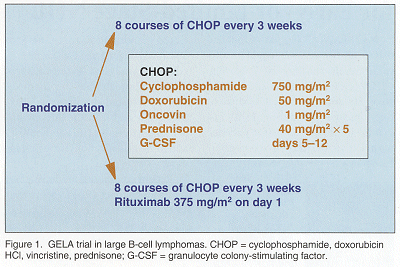CHOP Plus Rituxan Proves Cost-Effective in B-Cell Lymphoma
STANFORD, California-The cost-effectiveness of rituximab (Rituxan) combined with CHOP chemotherapy (cyclophosphamide [Cytoxan, Neosar], doxorubicin HCl, vincristine [Oncovin], prednisone) in the treatment of patients with diffuse large B-cell lymphoma compares favorably to other oncology therapies in this setting, according to a study presented at the 43rd Annual Meeting of the American Society of Hematology.
STANFORD, CaliforniaThe cost-effectiveness of rituximab (Rituxan) combined with CHOP chemotherapy (cyclophosphamide [Cytoxan, Neosar], doxorubicin HCl, vincristine [Oncovin], prednisone) in the treatment of patients with diffuse large B-cell lymphoma compares favorably to other oncology therapies in this setting, according to a study presented at the 43rd Annual Meeting of the American Society of Hematology.
Study Objective
The objective of the study was to estimate the cost-effectiveness of rituximab combined with CHOP (R-CHOP). The authors analyzed data from the Groupe d’Etude des Lymphomas de l’Adulte (GELA) study (see "
R-CHOP Benefits Increase Over Time for Aggressive Large B-Cell Lymphomas in Elderly
"), which compared the classic CHOP regimen with R-CHOP. The open-label trial enrolled 400 previously treated elderly patients (age range: 60-80 years) who were randomized between R-CHOP and CHOP (see Figure 1).

An interim analysis was conducted after at least 200 patients had been recruited, and 100 of those were followed for at least 1 year. "To assess the cost-effectiveness of R-CHOP vs CHOP, we estimated years of life gained, costs during treatment, and costs of years of life gained over the trial period," said coauthors John C. Hornberger, MD, Internal Medicine, Stanford University, and Acumen, LLC, and Jennie Best, also of Acumen.
The Study Model
The investigators developed a 10-year model because approximately 30% of the age group in the cohort were expected to survive for at least 10 years. Costs and survival were discounted at 3% and then used to calculate the cost-effectiveness ratio (costs per discounted life-year saved).
To estimate expected survival patterns for 10 years of follow-up, and thus project years of life gained, the investigators stratified trial-based data to an age-adjusted ratio based on the International Prognostic Index (IPI), and matched these data to the published evidence on long-term survival of diffuse large B-cell lymphoma patients.
Costs were estimated by applying French diagnostic-related group payments to trial data on hospital use and on treatments for adverse events. French drug prices and administration costs were used to estimate costs of R-CHOP and CHOP. Further, average annual costs of cancer surveillance following the treatments (euro value) were also based on published data.
Results and Conclusions
The investigators found that R-CHOP increased survival by 10% at 22 months (time of last event). Mean survival time for patients who met interim-analysis criteria was 724 days for R-CHOP and 645 days for CHOP, resulting in a mean increase in survival of 0.21 years. If this advantage, seen more than 1 year after completion of eight cycles of treatment, persists to 10 years, R-CHOP is predicted to increase mean survival by 0.8 life-years. Projecting costs over a 10-year period results in an estimated cost per year of life gained that is considered favorable by health authorities.
"Evidence from this trial supports the assumption that the combination R-CHOP regimen has the potential to result in a higher number of sustained cures, compared with the CHOP regimen," Dr. Hornberger said.
He noted that it would take additional follow-up of all of the trial’s randomized patients to provide more definitive evidence on the long-term durability of these findings. "However, current results firmly indicate that on the basis of cost-effectiveness, R-CHOP compares favorably with other oncology therapies that are in wide use today," Dr. Hornberger concluded.